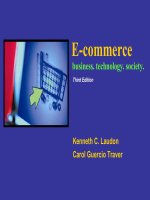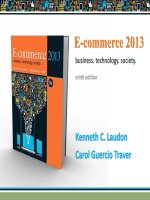Lecture E-commerce (7/e): Chapter 12 - Kenneth C. Laudon, Carol Guercio Traver
Bạn đang xem bản rút gọn của tài liệu. Xem và tải ngay bản đầy đủ của tài liệu tại đây (2.02 MB, 52 trang )
Ecommerce: business. technology.
society.
Ecommerce
business. technology. society.
seventh edition
Kenneth C.
Laudon
Carol Guercio
Traver
Copyright © 2011
Pearson Education, Inc.
Copyright © 2011 Pearson Education, Inc.
Chapter 12
B2B E-commerce: Supply Chain
Management and Collaborative
Commerce
Copyright © 2011
Pearson Education, Inc.
Copyright © 2010 Pearson Education, Inc.
Copyright © 2011 Pearson Education, Inc.
Slide 122
Volkswagen Builds Its B2B Net
Marketplace
Class Discussion
Why didn’t Volkswagen want to use a more open
or public electronic exchange for its parts
supply? Why didn’t it join an industry consortium
such as Covisint?
What kinds of services are provided by
VWGroupSupply?
What is eCAP and who benefits from its use?
Do you think suppliers are disadvantaged by this
B2B marketplace?
Copyright © 2011
Pearson Education, Inc.
Slide 123
Trends in B2B Ecommerce
Firms more comfortable with Internet security,
payments, helping expand use of B2B channels
Cloud computing and SaaS for B2B services
Growing realization that most important benefits
are not low costs of materials, but gains in
supply chain efficiency, better spend
management, improved business process
Rapid growth in collaborative commerce B2B
applications based on private networks
B2B communities emerge
Copyright © 2011
Pearson Education, Inc.
Slide 124
Defining B2B Commerce
Before
B2B
Total
transactions called trade or procurement process
inter-firm trade:
Total
B2B
All
B2B
Internet:
flow of value among firms
commerce:
types of computer-enabled inter-firm trade
e-commerce:
The
portion of B2B commerce enabled by the Internet
Copyright © 2011
Pearson Education, Inc.
Slide 125
Evolution of the Use of Technology
Platforms in B2B Commerce
Copyright © 2011
Figure 12.1, Page
765
Pearson Education, Inc.
Slide 126
Growth of B2B Commerce 20002014
Copyright © 2011
Pearson Education, Inc.
Figure 12.2, Page 768
SOURCES: Based on data from U.S. Census Bureau,
2010; authors’ estimates
Slide 127
The Growth of B2B Ecommerce
2009–2014:
B2B e-commerce will
grow from 30% to 35% of total interfirm trade
Private
industrial networks continue to
play dominant role in B2B
Non-EDI
B2B e-commerce most
rapidly growing type of e-commerce
EDI still large but
Copyright © 2011
Pearson Education, Inc.
time
will decline over
Slide 128
Industry Forecasts
Not
all industries similarly affected by B2B
e-commerce
Not all industries would benefit equally
Factors influencing move to e-commerce
Significant
utilization of EDI
Large investments in IT and Internet
infrastructure
e.g.
Aerospace and defense, computer, and
industrial equipment industries
Market concentrated on purchasing and/or
Copyright © 2011
Pearson Education, Inc.
Slide 129
selling
Potential Benefits of B2B Ecommerce
Lower
administrative costs
Lower search costs for buyers
Reduced inventory costs
Increasing
competition among suppliers
(increasing price transparency)
Reducing inventory carried
Lower
transaction costs:
Eliminating
paperwork
Automating parts of procurement process
Copyright © 2011
Pearson Education, Inc.
Slide 1210
Potential Benefits (cont’d)
Increased
production flexibility by ensuring
just-in-time parts delivery
Improved quality of products by increasing
cooperation among buyers and sellers
Decreased product cycle time by sharing
of designs and production schedules
Increased opportunities for collaborating
with suppliers and distributors
Greater price transparency
Copyright © 2011
Pearson Education, Inc.
Slide 1211
The Procurement Process and the Supply
Chain
Procurement
process:
The
way firms purchase materials they need to make
products
Supply
chain:
Firms
that purchase goods, their suppliers, and their
suppliers’ suppliers, and relationships and processes
involved
Steps
in procurement process
Deciding
who to buy from and what to pay
Completing transaction
Copyright © 2011
Pearson Education, Inc.
Slide 1212
The Procurement Process
Copyright © 2011
Pearson Education, Inc.
Figure 12.3, Page 770
Slide 1213
Types of Procurement
Firms
1.
2.
Direct goods: integrally involved in production
process
Indirect goods: All goods not directly involved in
production process (MRO goods)
Firms
1.
use two methods to purchase
Contract purchasing:
1.
purchase two types of goods
Involves long-term written agreements to purchase specified
products, with agreed-upon terms and quality
Spot purchasing:
Involves purchase of goods based on immediate needs in
Copyright © 2011
larger marketplaces that involve many suppliers
Pearson Education, Inc.
Slide 1214
Types of Procurement (cont’d)
Procurement
is highly information
intensive and labor intensive – 4.5 million
U.S. workers
Use
of Internet can simplify process and
reduce search, research, negotiating
costs, aid communication and
coordination
Multi-tier
supply chain
Copyright © 2011
Complex series of transactions between firm
Pearson Education, Inc.
Slide 1215
The MultiTier Supply Chain
Copyright © 2011
Pearson Education, Inc.
Figure 12.4, Page 772
Slide 1216
The Role of Existing Legacy
Computer Systems
Legacy
computer systems
Generally
older mainframe and minicomputer systems
used to manage key business processes within firm
MRP systems (Materials requirements planning)
Enable
firms to predict, track, and manage parts of
complex manufactured goods
ERP
systems (Enterprise resource
planning)
More
sophisticated MRP systems that include
human resources and financial components
Copyright © 2011
Pearson Education, Inc.
Slide 1217
Trends in Supply Chain Management and
Collaborative Commerce
Supply
chain management (SCM):
Wide
variety of activities that firms and
industries use to coordinate key players in
their procurement process
Major
developments in SCM
Supply
chain simplification
Electronic data interchange
Supply chain management systems
Collaborative commerce
Copyright © 2011
Pearson Education, Inc.
Slide 1218
Supply Chain Simplification
Essential for just-in-time production models
Typically achieved by:
Working
with strategic group of suppliers to reduce
product and administrative costs, while improving
quality
Purchasing under long-term contracts that contain
specified quality, cost, and timing goals
May involve
Joint
product development and design
Integration of computer systems
Tight coupling
Copyright © 2011
Pearson Education, Inc.
Slide 1219
Electronic Data Interchange (EDI)
Broadly defined communications protocol for
exchanging documents among computers
Stage 1: 1970s–1980s
Stage 2: Early 1990s
Document elimination
Stage 3: Mid-1990s
Document automation
Move toward continuous replenishment/access model
Today:
EDI provides for exchange of critical business information
between computer applications supporting wide variety of
Copyright © 2011
business processes
Pearson Education, Inc.
Slide 1220
The Evolution of EDI as a B2B Medium
Copyright © 2011
Pearson Education, Inc.
Figure 12.5, Page 774
Slide 1221
Supply Chain Management Systems
Continuously link activities of buying, making,
and moving products from suppliers to
purchasing firms
Integrates demand side of business equation by
including order entry system in the process
With SCM system and continuous
replenishment, inventory is eliminated and
production begins only when order is received
Hewlett Packard’s SCM system: Elapsed time
Copyright © 2011
from order entry to shipping PC is 48 hours. Slide 1222
Pearson Education, Inc.
Supply Chain Management Systems
Copyright © 2011
Figure 12.6, Page 777
Pearson Education, Inc.
Slide 1223
Insight on Technology
RFID Autoidentification:
Making Your Supply Chain Visible
Class Discussion
Why
is RFID an improvement over bar
codes?
How
does RFID work?
Why
is Wal-Mart supporting RFID?
What
impact will widespread adoption of
Copyright © 2011
RFID have on Internet B2B commerce?
Pearson Education, Inc.
Slide 1224
Collaborative Commerce
Use of digital technologies enabling
organizations to collaboratively design, develop,
build, and manage products through life cycles
Direct extension of SCM systems and supply
chain simplification
Involves move from transaction focus to
relationship focus among supply chain
participants
Unlike EDI, more like an interactive
teleconference among members of supply chain
Copyright © 2011
Example: Group Dekko
Pearson Education, Inc.
Slide 1225









